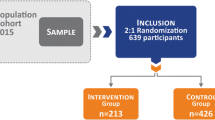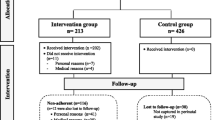Abstract
Background
Increases in clinical complications associated with maternal obesity have generated interest in increasing physical activity (PA) and exercise levels as an intervention to improve pregnancy outcomes.
Aims
The objective of this study was to examine the relationship between BMI categorisation and PA and exercise levels as pregnancy advances.
Methods
This was an observational study in a large university maternity hospital. Women were recruited at their convenience before they left hospital after delivering a baby weighing 500 g or more. They completed a detailed customised physical activity and exercise questionnaire. BMI categorisation was based on the measurement of weight and height in early pregnancy.
Results
Of the 155 women recruited, 42.5 % (n = 66) were primigravidas and 10.3 % (n = 16) were smokers. Mean Body Mass Index (BMI) was 24.6 kg/m2 and 14.2 % (n = 22) were obese, based on a BMI >29.9 kg/m2. Overall, women decreased their exercise from an average 194 min (range 0–650 min) per week pre-pregnancy to 98 min antenatally (range 0–420 min) (p < 0.0001). Obese women exercised least pre-pregnancy and antenatally at 187.5 and 75 min per week, respectively, compared with 193.2 and 95.5 min per week in the normal BMI group and 239.3 and 106.7 min per week in the overweight group. The mean gestation at which all women reduced their activity levels was 29 weeks.
Conclusions
We found that women decreased their PA and exercise levels significantly in the third trimester and, thus, in the absence of a medical contra-indication there is considerable scope for an exercise intervention to improve activity and exercise levels as pregnancy advances. However, an increase in PA levels in obese women needs further studies to determine whether it will improve the clinical outcomes for the woman and her offspring.





Similar content being viewed by others
References
World Health Organization (2008) 2008–2013 Action plan for the global strategy of the prevention and control of noncommunicable diseases
Sebire NJ, Jolly M, Harris JP et al (2001) Maternal obesity and pregnancy outcome: a study of 287,213 pregnancies in London. Int J Obes Relat Metab Disord 25:1175–1182
Barker DJ (1990) The fetal and infant origins of adult disease. BMJ 301:1111
Adamo KB, Ferraro ZM, Brett KE (2013) Can we modify the intrauterine environment to halt the intergenerational cycle of obesity? Int J Environ Res Public Health 9: 1263–1307. http://eutils.ncbi.nlm.nih.gov/entrez/eutils/elink.fcgi?dbfrom=pubmed&id=22690193&retmode=ref&cmd=prlinks
Catalano PM, Farrell K, Thomas A et al (2009) Perinatal risk factors for childhood obesity and metabolic dysregulation. Am J Clin Nutr 90: 1303–1313. http://eutils.ncbi.nlm.nih.gov/entrez/eutils/elink.fcgi?dbfrom=pubmed&id=19759171&retmode=ref&cmd=prlinks
Phelan S (2010) Pregnancy: a “teachable moment” for weight control and obesity prevention. Am J Obstet Gynecol 202(135):e1–e8
Caspersen CJ, Powell KE, Christenson GM (1985) Physical activity, exercise, and physical fitness: definitions and distinctions for health-related research. Pub Health Rep 100:126–131
Borg GAV (1982) Psychophysical bases of perceived exertion. Med Sci Sports Exerc 14:377–381
Physical activity guidelines for Americans (2008). US department of health and human services. www.health.gov/paguidelines
Get ireland active. Health service executive Ireland. www.getirelandactive.ie
Bell B, Dooley M (2006) Exercise in pregnancy. Royal college of obstetricians and gynaecologists statement no. 4
Clarke PE, Gross H (2004) Women’s behaviour, beliefs and information sources about physical exercise in pregnancy. Midwifery 20:133–141
Mottola MF, Campbell MK (2003) Activity patterns during pregnancy. Can J Appl Physiol 28:642–653
Clapp JF III, Kim H, Burciu B, Schmidt S, Petry K, Lopez B (2002) Continuing regular exercise during pregnancy: effect of exercise volume on fetoplacental growth. Am J Obstet Gynecol 186: 142–147. http://www.sciencedirect.com/science/article/pii/S0002937802323275
Ruiz JR, Perales M, Pelaez M, Lopez C, Lucia A, Barakat R (2013) Supervised exercise-based intervention to prevent excessive gestational weight gain: a randomized controlled trial. Mayo Clin Proc 88:1388–1397
Rasmussen KM, Yatkine AL (2009) Weight gain during pregnancy: reexamining the guidelines. Institute of Medicine and National Research Council of the National Academies, pp 1–250
O’Higgins AC, Doolan A, Mullaney L, Daly N, McCartney D, Turner MJ (2013) The relationship between gestational weight gain and fetal growth: time to take stock? 2013. J Perinat Med 42:1–7
Asbee SM, Jenkins TR, Butler JR, White J, Elliot M, Rutledge A (2009) Preventing excessive weight gain during pregnancy through dietary and lifestyle counseling: a randomized controlled trial. Obstet Gynecol 113:305–312
Turner MJ, Layte R (2013) Obesity levels in a national cohort of women 9 months after delivery. Am J Obstet Gynecol 209(124):e1–e7
Author information
Authors and Affiliations
Corresponding author
Ethics declarations
Conflict of interest
None of the authors had any financial or other potential conflicts of interests concerning this study.
Role of the funding source
This study did not require any funding.
Appendix: Physical activity and exercise during pregnancy questionnaire
Appendix: Physical activity and exercise during pregnancy questionnaire







Rights and permissions
About this article
Cite this article
Daly, N., Mitchell, C., Farren, M. et al. Maternal obesity and physical activity and exercise levels as pregnancy advances: an observational study. Ir J Med Sci 185, 357–370 (2016). https://doi.org/10.1007/s11845-015-1340-3
Received:
Accepted:
Published:
Issue Date:
DOI: https://doi.org/10.1007/s11845-015-1340-3




